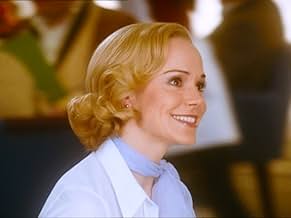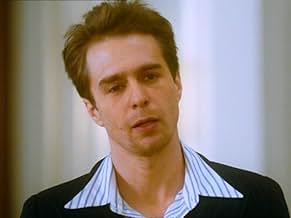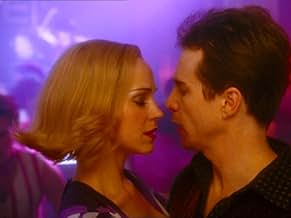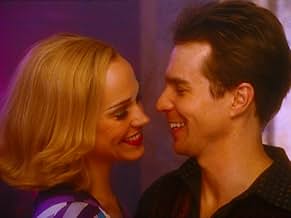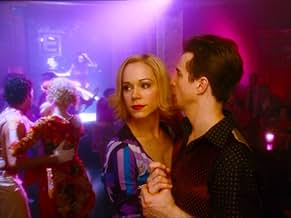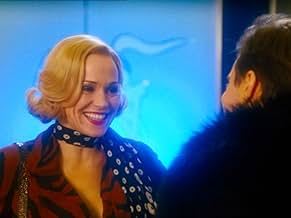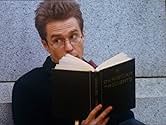AVALIAÇÃO DA IMDb
5,8/10
1,3 mil
SUA AVALIAÇÃO
Adicionar um enredo no seu idiomaSet in the 1930s, an American with a scandalous reputation on both sides of the Atlantic must do an about-face in order to win back the woman of his dreams.Set in the 1930s, an American with a scandalous reputation on both sides of the Atlantic must do an about-face in order to win back the woman of his dreams.Set in the 1930s, an American with a scandalous reputation on both sides of the Atlantic must do an about-face in order to win back the woman of his dreams.
- Direção
- Roteiristas
- Artistas
- Direção
- Roteiristas
- Elenco e equipe completos
- Produção, bilheteria e muito mais no IMDbPro
Avaliações em destaque
Following scriptwriter Julian Fellowes's Academy Award for Gosford Park (2001), and its commercial success with a recreation of 1930s Britain, he was able to initiate the third film version of Piccadilly Jim. In itself, this was no small achievement, for the last P.G. Wodehouse movie on the English big screen had been The Girl on the Boat forty years before.
The Piccadilly Jim that finally emerged from Fellowes's screenplay was an interpretation deeply at odds with Wodehouse humor, the result of the selection of a director, John McKay, who was mismatched with the story. Unlike Robert Altman's direction of Gosford Park, McKay found the concept of a period setting distracting and labored to undercut it in every way. McKay sought to avoid the world of Wodehouse television adaptations and their country-house weekends. In its stead, McKay asserts an equivalence between the 1930s, the 1960s, and the world of 2004, as all one and the same.
McKay noted, "I think P.G. Wodehouse inhabits a parallel universe to the period he is writing about, so we should find a parallel universe to suit this Piccadilly Jim. We thus decided we would make up our own 'thirties'...." Every bit of decor looks less like the ostensible 1930s setting than one of the decade's science fiction visions of the world as it would shortly become. The designs attempt to evoke the satires of the sterile stylization of modernism in films by Jacques Tati or Stanley Kubrick. However, McKay has no real vision of his own; instead Piccadilly Jim is chock-a-block modern with anachronisms and absurd inventions. McKay's defiantly iconoclastic visuals are incongruous, their lack of internal coherence constantly preventing viewers from immersing themselves in the world of the story. Equally at odds with any narrative unity is the singing of modern songs and the presence of 21st century retro automobiles.
Costumes and make up are particularly outlandish, especially unbelievable coiffures that spike, thrust, or droop to one side. The romantic leads vary scene by scene from Jim in an enormous fur coat and scarf, to Ann in modern boots, to Jim and Ann in contemporary nightclub dress with resonances to 1970s disco.
In attempting to modernize Wodehouse, McKay lacks any conception of what has made the author successful. The opening sequence provides a sharp comparison of the divergent approach between the film versions of Piccadilly Jim in 1936 and 2004. In the former, Bayliss wakens Jim from a late night to discover he is asleep with his feet on the pillow where his head ought to be. Such a tasteful indicator of insouciance from the 1930s is beyond the sensibility of 2004; in this version Bayliss finds Jim in bed with three scantily clad floozies. Nothing could have been farther from the harmless spirit of Wodehouse, even when he portrays marital mores and infidelity in such theatrical adaptations as Candle-Light.
The Piccadilly Jim of 2004 is a true wastrel, a womanizer, brawler, and drunkard who is deeply unsympathetic. Robert Montgomery, the Piccadilly Jim of 1936, might have played such a character in a likable manner, but instead of the classical Hollywood stars who could so perfectly embody Wodehouse characters, 2004 offers the modern Sam Rockwell. His performance lacks charm or charisma; he plays the role as standard issue "bad boy." Of course, according to contemporary romantic formula, this must be the secret wish of Ann, whose characterization is altered substantially. Instead of Nesta writing thrillers, as in the novel, it is Ann who composes them, incorporating criminal brutality that reflects her own volatile, slightly disturbed nature. Jim compares her speech to that of Sam Spade, and her devotion to murder is portrayed as the direct result of Jim's scathing review of the book of her poetry. Yet her first impression upon meeting Jim (she does not know his true identity until the end) is that he is too much of a "Mr. Nice Guy," lacking the dangerous edge for which she yearns. Frances O'Connor plays much of the role in varying tones of hysteria, and frequent, rather obvious dubbing reveal an actress having understandable difficulty with her role.
The greatest error is in eliminating the sincerity of the remorse Jim must feel. In the novel, love changes him, and only later does Jim realize why Ann hates the man she never met: he penned a vicious review of her book of poetry. This theme was retained, according to surviving plot synopses, in the original, now-lost faithful 1919 movie of Piccadilly Jim, with Owen Moore in the title role. The 1936 film of Piccadilly Jim had Jim pen cartoon parodies of the Pett family in retribution for their condescending treatment of his father, before Jim knew Ann was their relative. The 2004 version makes an alteration that ruins the credibility of Jim's transformation. The columns under the byline "Piccadilly Jim" were penned by a ghost writer, meaning that Jim never did actually wrong Ann. To compensate, he need do no more than punch the real writer in the nose. Without the need for contrition, Rockwell etches a Jim incapable of remorse, rendering the central conflict meaningless. All that remains is a playboy who has found an equally wild girl.
If a 21st century movie adaptation of Wodehouse requires actors like Rockwell who need to be introduced in bed with three women, there is indeed little place for Wodehouse in theatrical feature films. 1930s behavior is not the same as the present, and having Ann arrange for assignations with Jim, or making him give a goodbye kiss to Bayliss, masquerading as his father, only seem crass. Perhaps it is best for Wodehouse to remain on television, where he need only appeal to narrower, more literary audiences, comfortable with the flavor of another, more distant era.
The Piccadilly Jim that finally emerged from Fellowes's screenplay was an interpretation deeply at odds with Wodehouse humor, the result of the selection of a director, John McKay, who was mismatched with the story. Unlike Robert Altman's direction of Gosford Park, McKay found the concept of a period setting distracting and labored to undercut it in every way. McKay sought to avoid the world of Wodehouse television adaptations and their country-house weekends. In its stead, McKay asserts an equivalence between the 1930s, the 1960s, and the world of 2004, as all one and the same.
McKay noted, "I think P.G. Wodehouse inhabits a parallel universe to the period he is writing about, so we should find a parallel universe to suit this Piccadilly Jim. We thus decided we would make up our own 'thirties'...." Every bit of decor looks less like the ostensible 1930s setting than one of the decade's science fiction visions of the world as it would shortly become. The designs attempt to evoke the satires of the sterile stylization of modernism in films by Jacques Tati or Stanley Kubrick. However, McKay has no real vision of his own; instead Piccadilly Jim is chock-a-block modern with anachronisms and absurd inventions. McKay's defiantly iconoclastic visuals are incongruous, their lack of internal coherence constantly preventing viewers from immersing themselves in the world of the story. Equally at odds with any narrative unity is the singing of modern songs and the presence of 21st century retro automobiles.
Costumes and make up are particularly outlandish, especially unbelievable coiffures that spike, thrust, or droop to one side. The romantic leads vary scene by scene from Jim in an enormous fur coat and scarf, to Ann in modern boots, to Jim and Ann in contemporary nightclub dress with resonances to 1970s disco.
In attempting to modernize Wodehouse, McKay lacks any conception of what has made the author successful. The opening sequence provides a sharp comparison of the divergent approach between the film versions of Piccadilly Jim in 1936 and 2004. In the former, Bayliss wakens Jim from a late night to discover he is asleep with his feet on the pillow where his head ought to be. Such a tasteful indicator of insouciance from the 1930s is beyond the sensibility of 2004; in this version Bayliss finds Jim in bed with three scantily clad floozies. Nothing could have been farther from the harmless spirit of Wodehouse, even when he portrays marital mores and infidelity in such theatrical adaptations as Candle-Light.
The Piccadilly Jim of 2004 is a true wastrel, a womanizer, brawler, and drunkard who is deeply unsympathetic. Robert Montgomery, the Piccadilly Jim of 1936, might have played such a character in a likable manner, but instead of the classical Hollywood stars who could so perfectly embody Wodehouse characters, 2004 offers the modern Sam Rockwell. His performance lacks charm or charisma; he plays the role as standard issue "bad boy." Of course, according to contemporary romantic formula, this must be the secret wish of Ann, whose characterization is altered substantially. Instead of Nesta writing thrillers, as in the novel, it is Ann who composes them, incorporating criminal brutality that reflects her own volatile, slightly disturbed nature. Jim compares her speech to that of Sam Spade, and her devotion to murder is portrayed as the direct result of Jim's scathing review of the book of her poetry. Yet her first impression upon meeting Jim (she does not know his true identity until the end) is that he is too much of a "Mr. Nice Guy," lacking the dangerous edge for which she yearns. Frances O'Connor plays much of the role in varying tones of hysteria, and frequent, rather obvious dubbing reveal an actress having understandable difficulty with her role.
The greatest error is in eliminating the sincerity of the remorse Jim must feel. In the novel, love changes him, and only later does Jim realize why Ann hates the man she never met: he penned a vicious review of her book of poetry. This theme was retained, according to surviving plot synopses, in the original, now-lost faithful 1919 movie of Piccadilly Jim, with Owen Moore in the title role. The 1936 film of Piccadilly Jim had Jim pen cartoon parodies of the Pett family in retribution for their condescending treatment of his father, before Jim knew Ann was their relative. The 2004 version makes an alteration that ruins the credibility of Jim's transformation. The columns under the byline "Piccadilly Jim" were penned by a ghost writer, meaning that Jim never did actually wrong Ann. To compensate, he need do no more than punch the real writer in the nose. Without the need for contrition, Rockwell etches a Jim incapable of remorse, rendering the central conflict meaningless. All that remains is a playboy who has found an equally wild girl.
If a 21st century movie adaptation of Wodehouse requires actors like Rockwell who need to be introduced in bed with three women, there is indeed little place for Wodehouse in theatrical feature films. 1930s behavior is not the same as the present, and having Ann arrange for assignations with Jim, or making him give a goodbye kiss to Bayliss, masquerading as his father, only seem crass. Perhaps it is best for Wodehouse to remain on television, where he need only appeal to narrower, more literary audiences, comfortable with the flavor of another, more distant era.
It's 1930's London. Jim Crocker (Sam Rockwell) is the infamous Piccadilly Jim, a hard-partying playboy with a reputation for womanizing and fighting. His father Bingley Crocker (Tom Wilkinson) is a nice guy who only wants the best for him. His stepmother Eugenia Crocker (Allison Janney) is obsessed with social climbing the class system and win against her sister Nesta Pett (Brenda Blethyn). Jim falls utterly for Ann Chester (Frances O'Connor), but she utterly hates Piccadilly Jim although she has no idea what he looks like. He had written a bad review of her poems and ended her career. He assumes the false identity of Algernon Bayliss, a prim and proper Englishman, in order to pursue her.
To be fair, this movie is trying to be an outside-the-box comedy with a lot of eccentric touches. First, it's hard to buy Tom Wilkinson as the father of Sam Rockwell. Wilkinson is being his British self and Rockwell is going full out wild American. I'm sure that there are ways to explain the difference away. It just feels weird. The same goes for Allison Janney and Brenda Blethyn unless they grew up on the opposite sides of the Atlantic. Finally, I initially thought that Ann Chester is being played by Naomi Watts. I like Frances O'Connor, but she is ill-fitting in this role and I couldn't erase Naomi Watts from my mind.
I like some of this, but every other thing feels off. I'm never sure which part feels more wrong. It could be the differing tones. It could be the unrealism. It could be the unexpected turns. It's probably the odd casting. It could be all of them and more.
To be fair, this movie is trying to be an outside-the-box comedy with a lot of eccentric touches. First, it's hard to buy Tom Wilkinson as the father of Sam Rockwell. Wilkinson is being his British self and Rockwell is going full out wild American. I'm sure that there are ways to explain the difference away. It just feels weird. The same goes for Allison Janney and Brenda Blethyn unless they grew up on the opposite sides of the Atlantic. Finally, I initially thought that Ann Chester is being played by Naomi Watts. I like Frances O'Connor, but she is ill-fitting in this role and I couldn't erase Naomi Watts from my mind.
I like some of this, but every other thing feels off. I'm never sure which part feels more wrong. It could be the differing tones. It could be the unrealism. It could be the unexpected turns. It's probably the odd casting. It could be all of them and more.
I really had fun watching this movie. More like a play put in a film 9few location, great dialogs, situation and imbroglio comedy) but wait what a beautiful set design, the cast is great, the plot is vaudeville's but hey what do you aspect of a movie called: Picadily Jim! You will laugh, maybe not all the time, but the movie is construct on a good tempo and should entertain you. I really like those independent movies, not trying to create a new world but just trying to give us good time without taking us for granted.
Enjoy for what it is: a great moment of laugh, smiles and intelligence.
Thank you for the film
Enjoy for what it is: a great moment of laugh, smiles and intelligence.
Thank you for the film
This is the fourth filmed version of P. G. Wodehouse's comic novel of the same name. It was filmed in 1919 (directed by Wesley Ruggles, younger brother of the actor Charlie Ruggles) and in 1936 (directed by Robert Z. Leonard and starring Robert Montgomery), both times under its correct title. It was next filmed under the title THE GIRL ON THE BOAT (1961), directed by Henry Kaplan, and featuring the famous comedian Norman Wisdom as well as Millicent Martin, Richard Briers, and others of note. And then for this production of 2005, they went back to the original title again. 'Piccadilly Jim' is a wild young man who is the main character, and should be played by somebody truly extraordinary. Unfortunately, here he is played by a somewhat colourless actor who is about as interesting as a crushed toadstool, Sam Rockwell. However, the other performers do their best to 'act around him' and cover up the vacuum of his performance with their own energetic, and often hysterical performances. Tom Wilkinson is a steadying factor, good dependable Tom who can never let anyone down, including his son in this film, played by the nonentity aforementioned. The script by Julian Fellowes, the approach, the director, the design, all conspire in unison to leave the true Edwardian Age behind and enter into an overt fantasy-Edwardian Age for younger audiences who never knew any real Edwardians and might not realize just how hilarious every word that Wodehouse ever wrote really was. For those of us who knew genuine Edwardians (not to mention not a few surviving ancient Victorians as well), the fun of Wodehouse is the way he mocks, taunts, and teases the authentic types of the period by depicting them as the most outrageous caricatures imaginable. And as everyone knows, a good caricature only works if it closely resembles its subject. This film does not closely resemble anything that ever really existed, and was not planned to do so. I personally prefer the Wodehouse adaptations which affectionately and outrageously distort the truth, as opposed to this approach, which is to forget satire altogether and invent a wholly new truth where it is comedy rather than satire that is really the aim. For authentic vintage Wodehouse, one should see the three successive TV series called WODEHOUSE PLAYHOUSE, starring the amazing John Alderton, from the 1970s. Here it must be said that the design, the costumes, the look, are all simply dazzling. Taken in its own right, and forgetting its origins, this film is a tour de force of over-the-top but certainly scintillating fantasy. It takes the word 'camp' and raises it to a higher power. It is also great fun. But it is strictly for non-Purists only. I suppose that makes me impure.
The mix of contemporary references and modern scenery, in what was ostensibly a period piece, just makes this film annoying. On top of this, the movie proves that Frances O'Connor cannot act, and that surrounding her with good actors and actresses will only increase the pain she causes audiences. Sadly, I really wanted to like this movie, but could not do so -- I love P.G. Woodehouse's work, and it is all eminently adaptable to film. Yet, somehow, the makers if this fiasco failed in what should have been a simple and enjoyable endeavor. This could either have been a period piece, or a modern adaptation, yet it is neither -- instead it is a mish-mash of references best suited for some sort of high school dramatic review. Do not pay money to see this!
Você sabia?
- CuriosidadesFirst film appearance of Sia. She appears briefly as a singer in a bar and, unusually, her entire face is clearly visible!
- Citações
Ann Chester: It's too bad you don't have any bad habits. We could have had ourselves a good time on that old boat.
- ConexõesVersion of Piccadilly Jim (1919)
Principais escolhas
Faça login para avaliar e ver a lista de recomendações personalizadas
- How long is Piccadilly Jim?Fornecido pela Alexa
Detalhes
- Data de lançamento
- Países de origem
- Idioma
- Também conhecido como
- Piccadilly Jim
- Locações de filme
- Empresas de produção
- Consulte mais créditos da empresa na IMDbPro
Bilheteria
- Orçamento
- US$ 15.000.000 (estimativa)
- Tempo de duração1 hora 37 minutos
- Cor
- Mixagem de som
- Proporção
- 2.35 : 1
Contribua para esta página
Sugerir uma alteração ou adicionar conteúdo ausente

Principal brecha
By what name was Aprontando Todas (2004) officially released in Canada in English?
Responda
